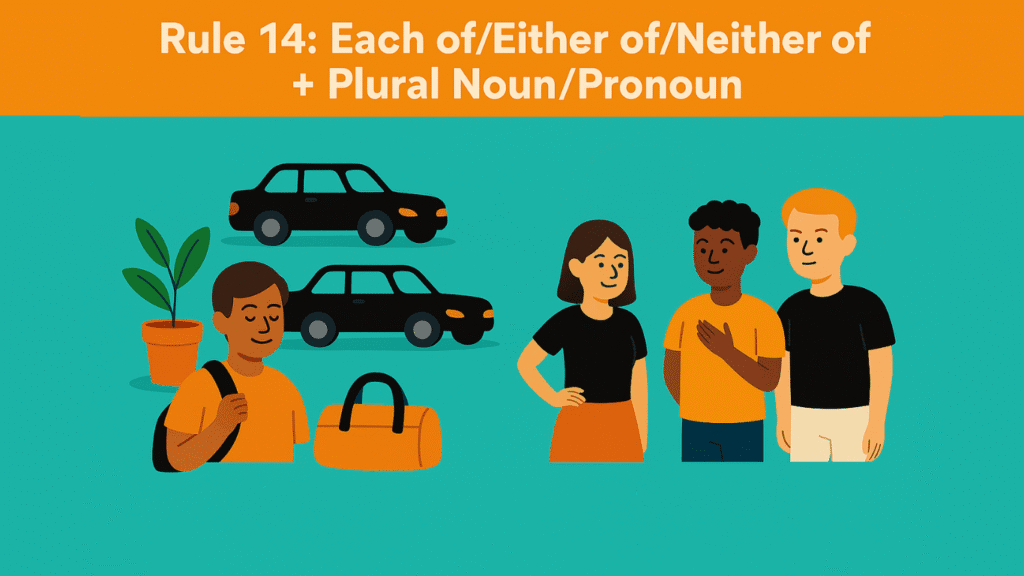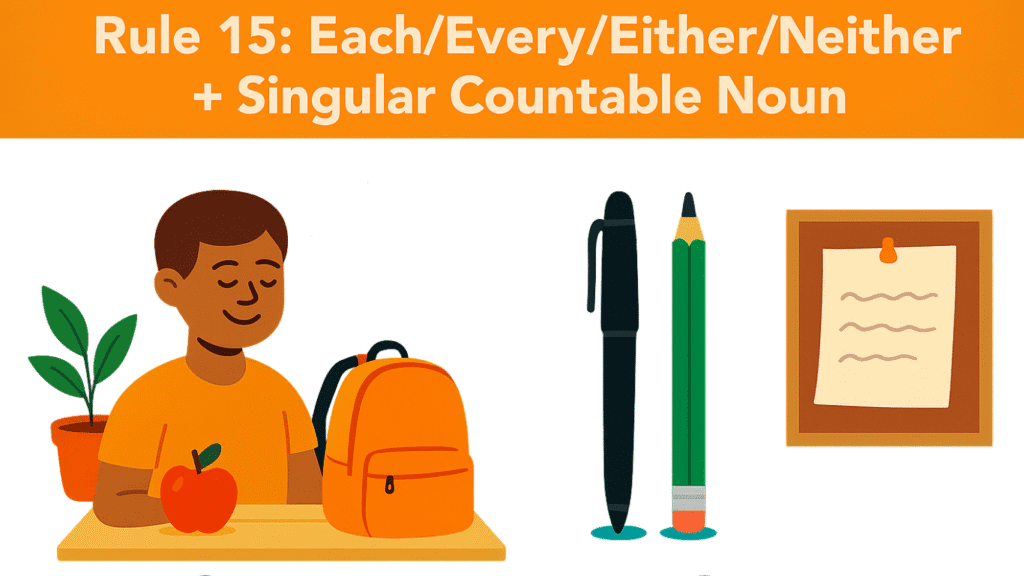
Welcome back to the third installment of our English grammar series! If you’re preparing for competitive exams like PSSSB, PCS, Punjab Police, Punjab Patwari, Excise Inspector, or any other state-level test, you’re in the right place. In this article, we’ll dive into the next five grammar rules that are crucial for acing your exams. Don’t forget to check out the Part 1 and part 2 of this series if you haven’t already. Let’s make grammar fun, engaging, and easy to understand—with a dash of humor and interesting facts to keep you hooked!
Table of Contents
Rule 11: When Two Adjectives Describe a Singular Noun of Grammar

Imagine two adjectives holding hands and describing a singular noun. If they’re connected by and and only the first adjective has an indefinite article (a/an), they’re talking about one person or thing. In this case, use a singular verb.
Example:
- Correct: A black and white cat was mewing. (One cat with two colors.)
- Incorrect: A black and white cat were mewing.
But wait! If both adjectives have their own a/an, they’re describing two different things or people. Now, you need a plural verb.
Example:
- Correct: A black and a white cat were mewing. (Two cats: one black, one white.)
- Incorrect: A black and a white cat was mewing.
Fun Fact: Did you know that cats can make over 100 different sounds? Maybe the black and white cats were having a full-on conversation!
Rule 12: Each and Every with Singular Nouns

When two singular nouns are joined by and and preceded by each or every, they’re treated as a singular subject. Use a singular verb.
Examples:
- Each pen and pencil is black. (Correct)
- Each pen and each pencil is black. (Correct)
- Each pen and each pencil are black. (Incorrect)
- Every boy and girl is laborious. (Correct)
- Every boy and every girl is laborious. (Correct)
- Every boy and every girl are laborious. (Incorrect)
Pro Tip: Think of each and every as strict teachers who insist on singular verbs. No exceptions!
Rule 13: The Versatile “Each”

When each is used as the subject of a sentence, it’s always followed by a singular verb.
Example:
- Each has a bag. (Correct)
- Each have a bag. (Incorrect)
However, when each follows a plural noun or pronoun, it takes a plural verb.
Examples:
- We each have a car. (Correct)
- We each has a car. (Incorrect)
- The boys each have a cycle. (Correct)
- The boys each has a cycle. (Incorrect)
Interesting Fact: The word each comes from Old English ǣlc, meaning “every, any.” It’s been keeping grammar rules strict for centuries!
Rule 14: Each of/Either of/Neither of + Plural Noun/Pronoun

When these phrases are used as the subject, they’re followed by a singular verb.
Examples:
- Each of five cars is black. (Correct)
- Each of five cars are black. (Incorrect)
- Either of those two persons is kind. (Correct)
- Either of those two persons are kind. (Incorrect)
- Neither of you knows German. (Correct)
- Neither of you know German. (Incorrect)
Humorous Note: If you say, “Neither of you know German,” you might get a response like, “Neither of you knows grammar!”
Rule 15: Each/Every/Either/Neither + Singular Countable Noun

When these words are followed by a singular countable noun, they take a singular verb.
Examples:
- Each boy was smart. (Correct)
- Each boy were smart. (Incorrect)
- Either pen writes well. (Correct)
- Either pen write well. (Incorrect)
Grammar Gems:
- Each, either, and neither are called distributive pronouns.
- When used before a noun, they become distributive adjectives.
- Each refers to every one in a group of two or more.
- Either means one of two.
- Neither means none of two.
- Every refers to all members of a group of three or more.
Fun Fact: The word either can be pronounced as “ee-ther” or “eye-ther.” Both are correct, so you can’t go wrong!
Practice Time!
Let’s test your understanding. Fill in the blanks with the correct verb:
- Each of the students _____ (is/are) present.
- A red and a blue car _____ (was/were) parked outside.
- Every man and woman _____ (has/have) a role to play.
- Neither of the books _____ (interest/interests) me.
- Each pen and pencil _____ (is/are) on the desk.
Answers:
- is
- were
- has
- interests
- is
Engage with Us!
How did you do on the practice questions? Did any rule surprise you? Share your thoughts in the comments below! If you found this article helpful, don’t forget to share it with your friends who are also preparing for competitive exams. Let’s make grammar learning a fun and collaborative journey.
Stay tuned for the next part of this series, where we’ll uncover more grammar secrets. Until then, keep practicing and keep smiling! 😊
FAQs for “Mastering Grammar: Essential Rules for Competitive Exams”
1. What is the focus of this article?
This article focuses on explaining essential grammar rules that are crucial for competitive exams like PSSSB, PCS, Punjab Police, Punjab Patwari, Excise Inspector, and other state-level tests. It is the third part of a series dedicated to mastering grammar for exam preparation.
2. Who should read this article?
This article is specifically designed for:
Aspirants preparing for competitive exams.
Students who want to strengthen their grammar skills.
Anyone looking for clear, concise, and engaging explanations of grammar rules.
3. What are the key grammar rules covered in this article?
The article covers the following rules:
Using two adjectives with a singular noun.
The use of each and every with singular nouns.
The correct use of each as a subject or after plural nouns.
The use of each of, either of, and neither of with plural nouns/pronouns.
The use of each, every, either, and neither with singular countable nouns.
4. How can I practice these grammar rules effectively?
Read the examples provided in the article carefully.
Attempt the practice questions at the end of the article.
Use grammar books or online resources for additional exercises.
Regularly revise the rules to reinforce your understanding.
5. Why are these grammar rules important for competitive exams?
These rules are frequently tested in competitive exams to evaluate a candidate’s understanding of subject-verb agreement, singular and plural usage, and distributive pronouns/adjectives. Mastering these rules can help you avoid common mistakes and score higher in the English section.
6. What should I do if I find grammar rules confusing?
Break down the rules into smaller parts and understand each component.
Use real-life examples to make the rules relatable.
Practice consistently to build confidence.
Refer to the previous parts of this series for a stronger foundation.
7. Can I use these grammar rules in everyday English?
Absolutely! These rules are not just for exams but are also essential for effective communication in everyday English. Whether you’re writing an email, speaking in public, or having a conversation, these rules will help you express yourself clearly and correctly.
8. Can I suggest topics for future articles?
Yes, we’d love to hear from you! If you have specific grammar topics or exam-related questions you’d like us to cover, leave a comment below or reach out to us via email.
